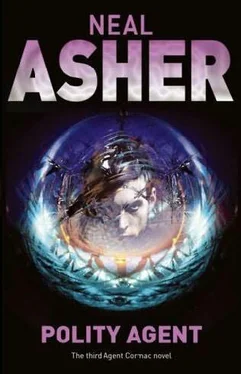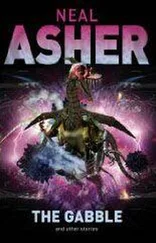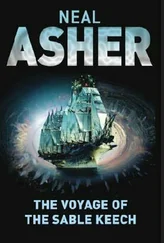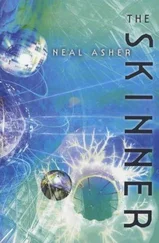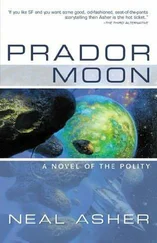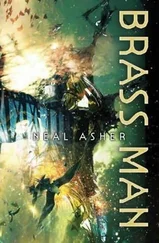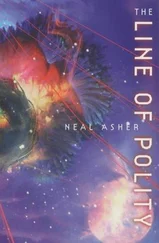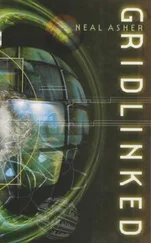* * * *
The mycelium carried out its task with admirable efficiency, though in the process it emptied all the Heliotrope’s energy reserves and was now placing a huge drain on the reactor. As a consequence, the power to the larger drill she was putting through the crust kept being cut. The hole diameter needed to be larger so that she could force down through it the five slow-burn CTDs presently waiting ready at the top of the shaft. Without them, the temperature would be a problem for her purpose. A third of the chlorine collected by the mycelium and released by it into currents in the methane sea, had dispersed in particulate form, and two thirds of it had coagulated in a layer under the crust directly below her. This low-temperature mix would not be sufficient for her needs. However, detonating four of the bombs at a depth of two hundred yards below the crust would create a huge bubble consisting of a mix of gaseous chlorine and methane. She estimated the pressure increase produced would lift the crust at least a hundred feet, and cause it to start breaking apart. No problem there, though, for before it got a chance to blow the gas mix out into space, the time-delay switch on the fifth CTD would then operate. The extra heat this would provide was incidental, the intense flash of light it produced being more important.
Orlandine sat back and remembered being eight years old and observing a demonstration in a basic chemistry class. The whole lesson had been conducted in a virtuality, but that did not change the fundamental facts. She and her classmates had sat in a representation of a pre-millennial classroom, while the AI in charge apparated as an old gentleman in Victorian garb. Inside a cabinet, whose front door was armour-glass, rested a conventional glass vessel filled with misty gas. Behind this, screwed into the back of the cabinet, was an ancient filament light bulb. The bulb came on with a dull red glow.
‘As you can see,’ the teacher pointed out, ‘no reaction. Red light does not contain sufficient energy to split chlorine molecules. But now, observe.’
While she watched, the chemical formulae had played in her mind, through her early haiman implants, and she understood those formulae just as she understood mathematics, on an almost instinctive level. The light bulb grew brighter, changing to a blue-white glare. Instantly the glass vessel exploded.
‘The photochlorination of methane,’ the teacher explained. ‘The light needs a wavelength of no more than 494nm to split the chlorine molecules into radicals, which can then combine with the methane to form methane radicals and hydrochloric acid. This is an example of a strong, exothermic chain reaction. Now let us look at this in detail…’
The classroom faded and, from a vantage in albescent space, the pupils observed a nanoscope view of the actual molecules and their reaction. As Orlandine recollected, the lesson then moved on to the quantum processes involved—basic chemistry for haiman children had been rather more advanced than for others.
Photochlorination.
She needed to destroy the USER located here, and that early chemistry lesson provided an elegant solution. If everything went to plan she could fire the CTDs down to their designated positions within the hour. Orlandine smiled to herself and, still linked via her carapace to the operation she was conducting, she availed herself of hot coffee from the spigot provided within Heliotrope’s interface sphere. It seemed almost inevitable that, at that very moment of relaxation, the ship’s detectors should pick up movement from the nearby surface installation.
* * * *
I have got a headache, thought Jack, and when another part of himself added but AIs don’t get headaches he realized that the crystal containing his consciousness had not escaped unscathed. This was not entirely surprising. His diagnostic returns took up a substantial proportion of his processing space, and on the whole they indicated the NEJ to be a write-off. The gravtech weapons nacelle had been torn away, and one of the nacelles for conventional weapons inverted inside the ship, and much of what it contained turned inside-out as well. Luckily it contained no CTDs since antimatter would have reacted rather violently with the substance of the NEJ. One conventional weapons nacelle remained undamaged, which was rather surprising considering the state of the rest of the ship, though according to Jack’s current manifest it contained only two CTD imploder missiles and a rack of space mines still locked in the carousel.
The forces exerted on the NEJs hull had twisted it into the shape of a section of metal drill bit. Inside, corridors, cabins and other spaces were distorted or flattened. One reactor had been cracked like a walnut and now leaked radioactives throughout the ship. Much of the intricate machinery inside appeared to have been put through a shredding press.
Um, definitely wouldn’t be any survivors, Jack observed. His other half tended to agree, though not vocally, for it was losing its independence as he gradually programmed in reconnections at the shear interface in his mind’s crystal.
Searching through the diagnostic data for some idea about the state of the U-space engine, Jack finally understood there was no data available. After many hours of easing a small robot through the wreckage to find and repair optic feeds, he finally managed to reconnect to all his pin-cams. The U-space engine was notable by its absence: however, he found the fusion engine, still in one piece, though with all its fuel and power lines sheared away.
I do not hold out much hope for his recovery, Jack commented, now directing all his resources to excavating through shattered and twisted composite structural beams to reach the U-space communicator. Some hours later a crab-shaped robot, no larger than the palm of a man’s hand, eased its way through a crevice and found the remains of the device he sought. A subsequent investigation of nearby stores rendered the first good news: Jack located a U-space beacon capable of sending a distress signal. However, that signal would remain uncoded—just a loud shout for help. Jack rattled metaphorical fingers on a metaphorical desk, and wondered if such a cry might resemble that of a snared rabbit calling for help at the mouth of a fox’s den. Before making the call, he decided it might be a good idea to repair all the control optics leading to that one remaining nacelle, and see what he could do about connecting up the fusion engine again. Almost with a sigh he set the remaining robots and telefactors to work inside his wrecked carcase.
* * * *
The planetoid mass of enemy ships took on the shape of a galactic lens while those ships departed it, separating from one massive bio-mechanical structure. The Battle Wagon’s, huge acceleration towards this mass demonstrated, more than anything else, that either no humans or other fragile creatures were aboard that vessel, or that its controlling AI deemed them dispensable. Those ships that could keep up with it, covered the attack run, the rest were finding enough problems of their own.
With cold logic, Azroc noted that only half of the Polity dreadnoughts remained viable but, worse than this, the other half had not all been destroyed, for the enemy controlled at least twenty of them. One consequence of this was intermittent communication, as com channels needed to be perpetually switched and re-encoded. Some ships, despite this and despite possessing com systems hardened against Jain-based informational attack, were nevertheless subsumed by such attacks. As he observed, in his mind, the spreading mass of enemy ships, Azroc could not for long remain coldly logical, since still ninety per cent of them had yet to engage. The Polity was losing, and there would be no help while that USER still functioned. And plotting its field strength revealed its position at the remote edge of the system—many days away under conventional drives, even if any of the Polity ships could disengage themselves to head out that way.
Читать дальше
